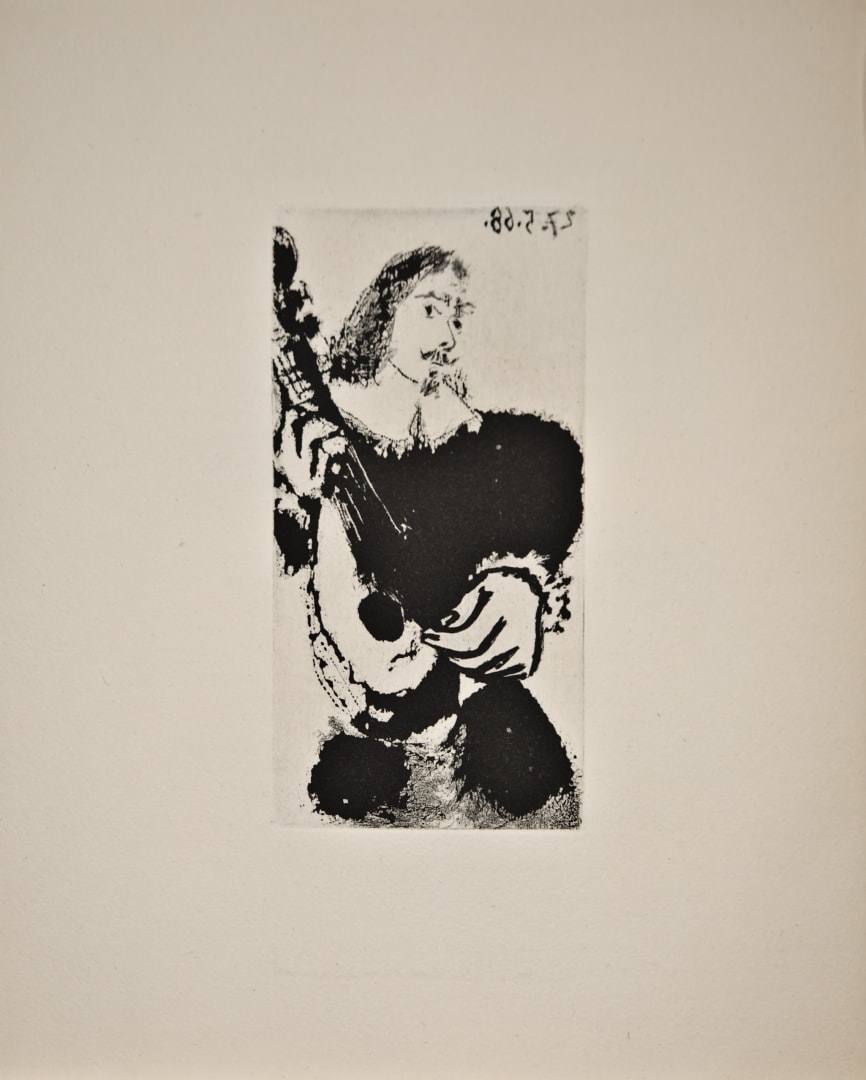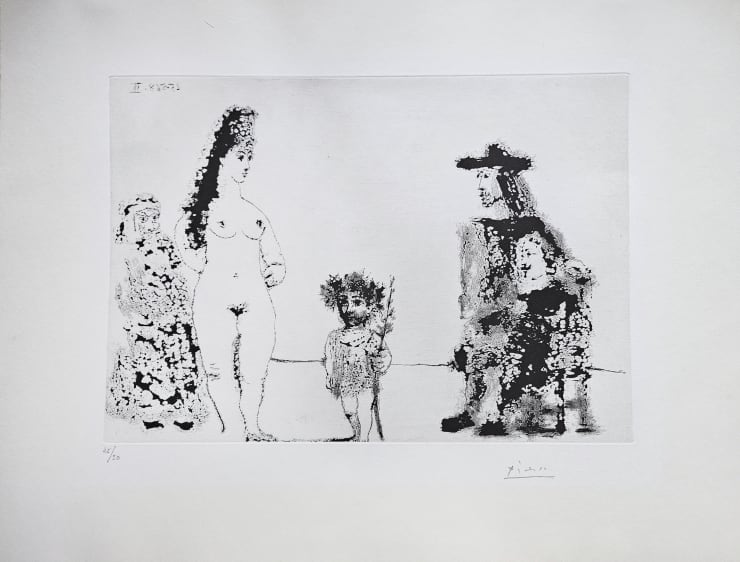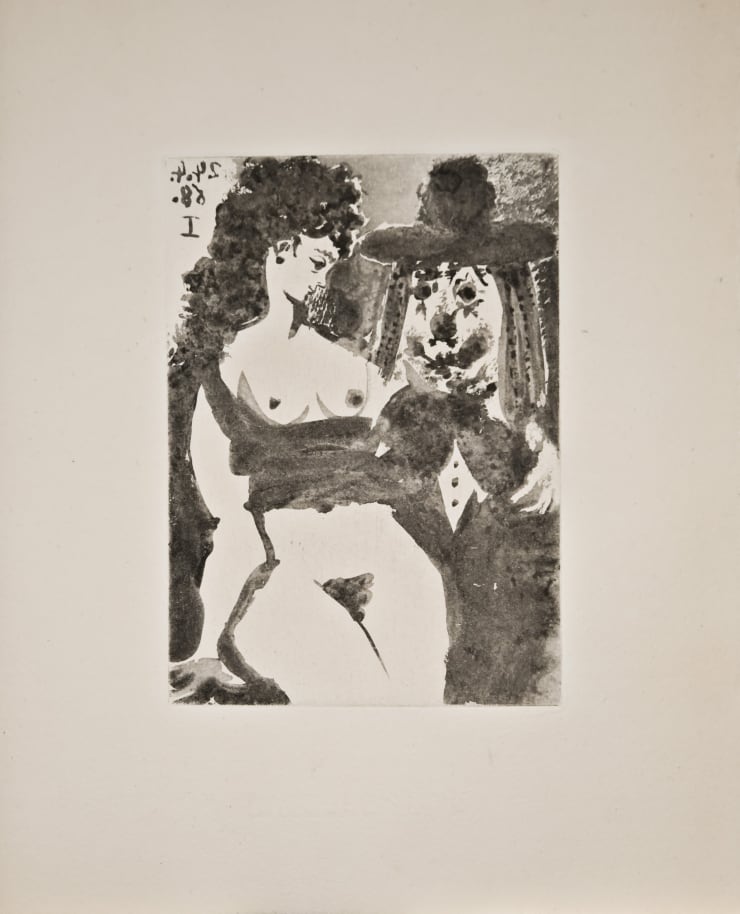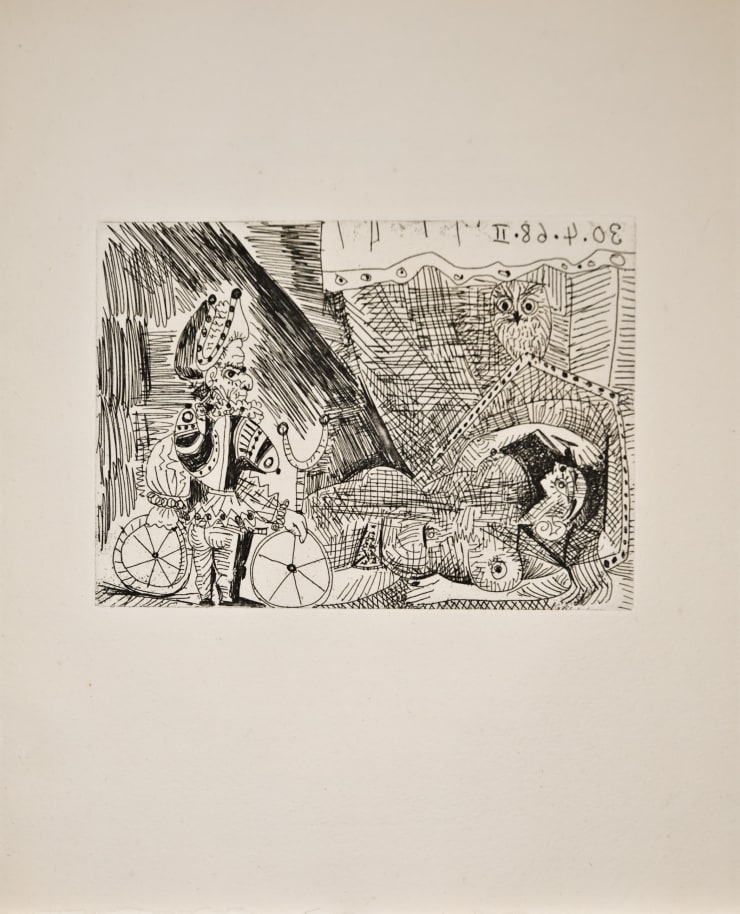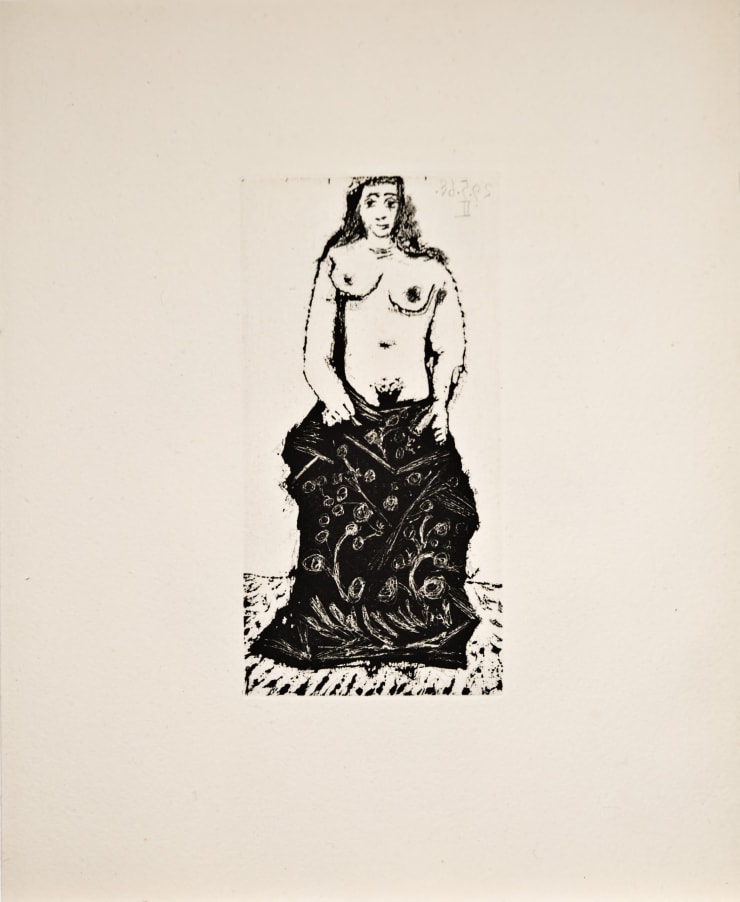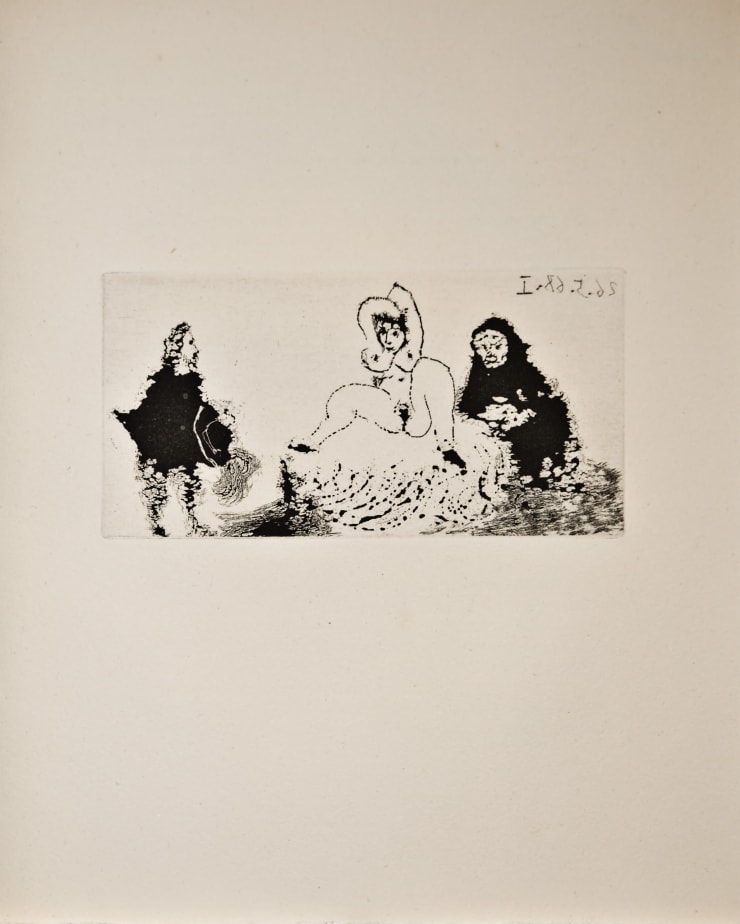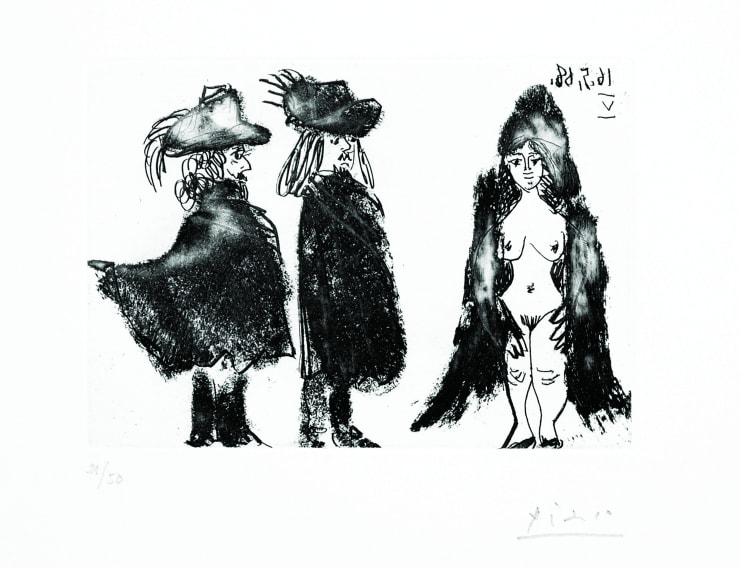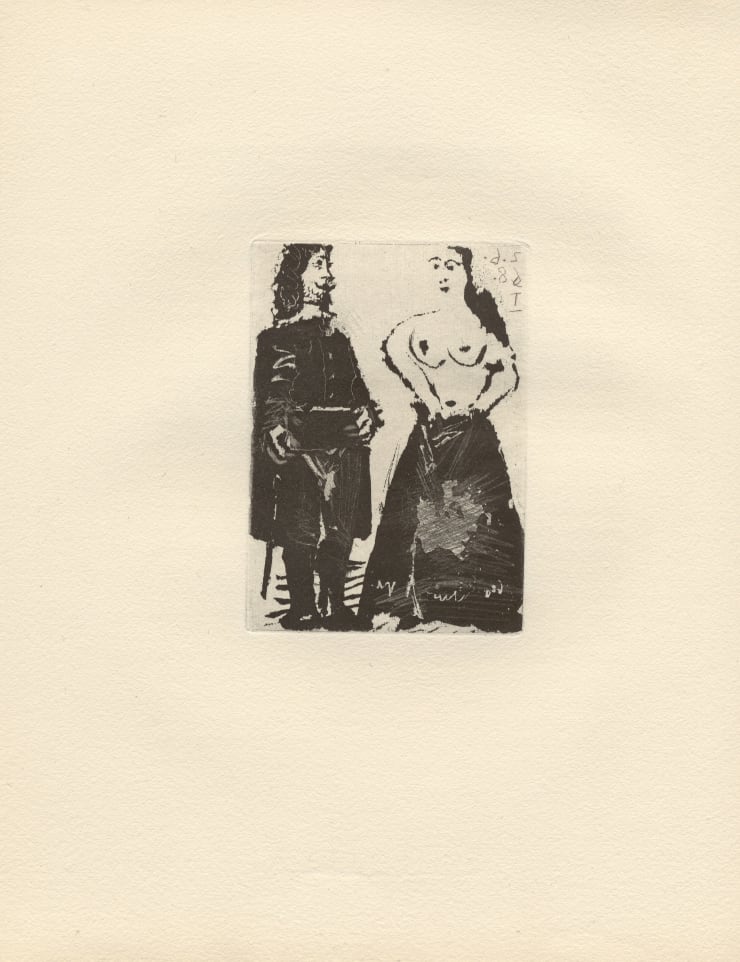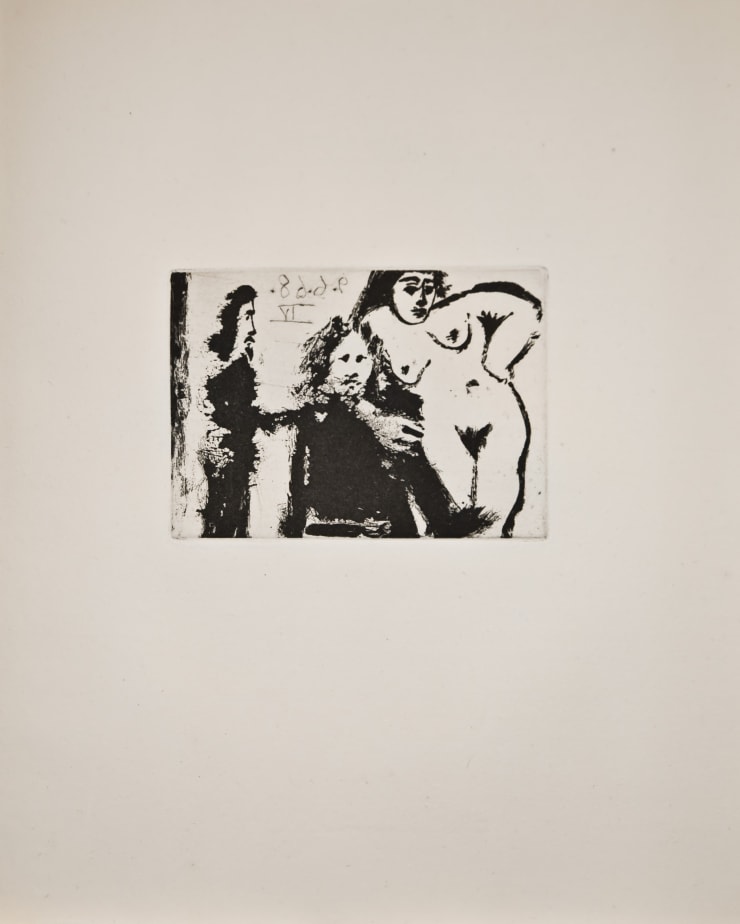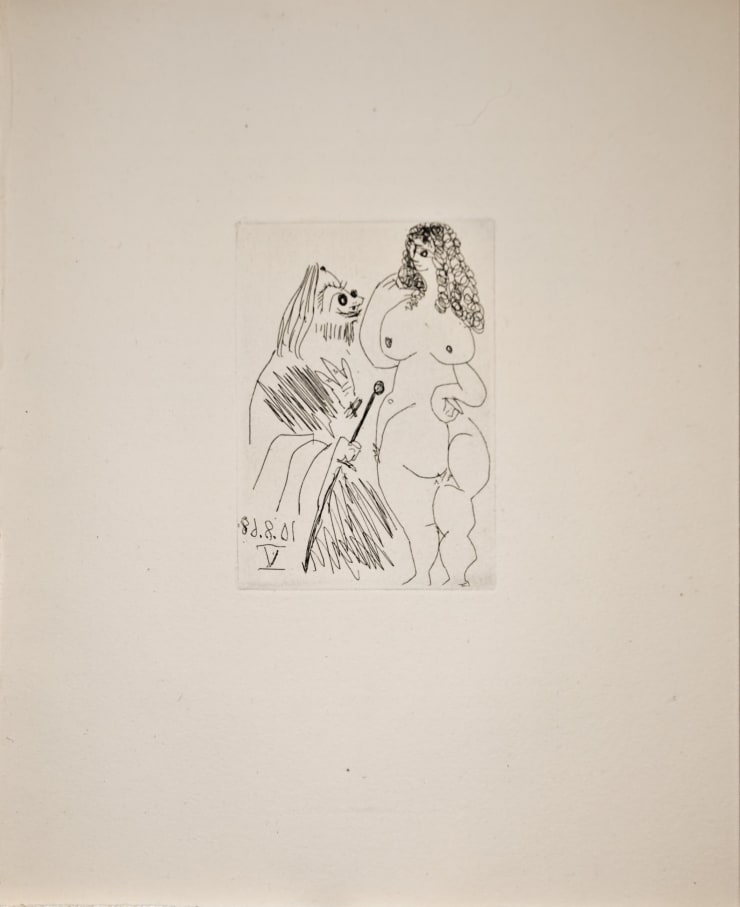La Celestine from Series 347
La Celestine is a subset of sixty-six prints within the larger series created in 1968, known as 347 Suite. It was created partially in reaction to the conceptual, theoretical, history-rejecting art that was gaining popularity in the 1960s – and the resistance to this youthful project likely made Picasso feel quite old, since he was once a leader in such movements. Rather contrarily, for this suite Picasso turned once more to mythology, this time to Spanish folklore. The La Celestine series takes up a character named Célestina from a Renaissance-aged fable, Tragicomedia de Calisto y Melibea. Formerly a prostitute, she has become the elderly, greedy owner of a brothel, and a meddler in the town’s love affairs. Célestina is always depicted as haggardly, almost monstrously, old; her withered body matches her barren soul. She could be understood as a reflection of Picasso’s aging anxieties. In his late 80s, the artist was worried equally about his place in the art world, his absent sexuality, and his creative potency.
Perhaps as a way of working out his troubled psyche, in this series he loosed his full arsenal of technical ability – the prints are done as etchings, drypoints, copper engravings, as well as in the aquatint techniques he’d learned in Roger Lacourière’s workshop. These represent a lifetime of experimentation, mastery, and, more than anything, a lifelong search for new means of expression. This pursuit never dwindled, even as – or it could be said, especially as – his art began to contemplate the predicament of the aging soul.
-
 La Célestine présente sa pupille; avec un enfant au rameau d'olivier (Bloch 1591), 1968
La Célestine présente sa pupille; avec un enfant au rameau d'olivier (Bloch 1591), 1968 -
 Femme se coiffant (Bloch 1507), 1968 (April 11.IV, Mougins)
Femme se coiffant (Bloch 1507), 1968 (April 11.IV, Mougins) -
 Vieux Clown avec une ravissante personne (Bloch 1529), 1968 (April 24.I, Mougins)
Vieux Clown avec une ravissante personne (Bloch 1529), 1968 (April 24.I, Mougins) -
 Polichinelle avec un Bicyclette d'Acrobate, et Odalisque au Hibou (Bloch 1540), 1968 (April 30.II, Mougins)
Polichinelle avec un Bicyclette d'Acrobate, et Odalisque au Hibou (Bloch 1540), 1968 (April 30.II, Mougins) -
 Vieux Faune avec une Poupée vivante (Bloch 1558), 1968 (May 12.IV, Mougins)
Vieux Faune avec une Poupée vivante (Bloch 1558), 1968 (May 12.IV, Mougins) -
 Maja à la Robe déchirée (Bloch 1607), 1968 (May 29.IV, Mougins)
Maja à la Robe déchirée (Bloch 1607), 1968 (May 29.IV, Mougins) -
 Maja à la Robe courte (Bloch 1606), 1968 (May 29.III, Mougins)
Maja à la Robe courte (Bloch 1606), 1968 (May 29.III, Mougins) -
 Maja à la Robe longue (Bloch 1605), 1968 (May 29.II, Mougins)
Maja à la Robe longue (Bloch 1605), 1968 (May 29.II, Mougins) -
 Odalisque (Bloch 1601), 1968 (May 29.I, Mougins)
Odalisque (Bloch 1601), 1968 (May 29.I, Mougins) -
 La Sérénade (Bloch 1599), 1968 (May 27.D, Mougins)
La Sérénade (Bloch 1599), 1968 (May 27.D, Mougins) -
 Une Maja posant sur un Piédestal (Bloch 1598), 1968 (May 27.C, Mougins)
Une Maja posant sur un Piédestal (Bloch 1598), 1968 (May 27.C, Mougins) -
 Duel, avec un Spectateur nu (Bloch 1597), 1968 (May 27, Mougins)
Duel, avec un Spectateur nu (Bloch 1597), 1968 (May 27, Mougins) -
 Homme nu assis en Tailleur, et deux Femmes (Bloch 1600), 1968 (May 27, Mougins)
Homme nu assis en Tailleur, et deux Femmes (Bloch 1600), 1968 (May 27, Mougins) -
 Peintre, Modèle et Visiteur (Bloch 1596), 1968 (May 27, Mougins)
Peintre, Modèle et Visiteur (Bloch 1596), 1968 (May 27, Mougins) -
 Vieux Beau saluant Très bas une Pupille de la Célestine (Bloch 1593), 1968 (May 26.II, Mougins)
Vieux Beau saluant Très bas une Pupille de la Célestine (Bloch 1593), 1968 (May 26.II, Mougins) -
 Gentilhomme en visite chez la Célestine (Bloch 1592), 1968 (May 26.I, Mougins)
Gentilhomme en visite chez la Célestine (Bloch 1592), 1968 (May 26.I, Mougins) -
 Célestine, Fille et vieux Client (Bloch 1588), 1968 (May 24.II, Mougins)
Célestine, Fille et vieux Client (Bloch 1588), 1968 (May 24.II, Mougins) -
 Célestine et Fille, avec un Chat et un jeune Client (Bloch 1587), 1968 (May 24.I, Mougins)
Célestine et Fille, avec un Chat et un jeune Client (Bloch 1587), 1968 (May 24.I, Mougins) -
 Couple en Carrosse et pauvre Piéton (Bloch 1583), 1968 (May 21.III, Mougins)
Couple en Carrosse et pauvre Piéton (Bloch 1583), 1968 (May 21.III, Mougins) -
 La Célestine. Fuite (Bloch 1582), 1968 (May 21.II, Mougins)
La Célestine. Fuite (Bloch 1582), 1968 (May 21.II, Mougins) -
 La Célestine présentant ses Deux Pensionnaires à Deux Clients (Bloch 1581), 1968 (May 21.I, Mougins)
La Célestine présentant ses Deux Pensionnaires à Deux Clients (Bloch 1581), 1968 (May 21.I, Mougins) -
 Cavalier et son valet, et Jeune Fille vêtue d’une mante (Bloch 1576), 1968 (May 16.V, Mougins)
Cavalier et son valet, et Jeune Fille vêtue d’une mante (Bloch 1576), 1968 (May 16.V, Mougins) -
 Jeune fille, Célestine et Petit-Maître (Bloch 1575), 1968 (May 16.IV, Mougins)
Jeune fille, Célestine et Petit-Maître (Bloch 1575), 1968 (May 16.IV, Mougins) -
 Mille et une Nuits et Célestine: la jeune Esclave (Bloch 1574), 1968 (May 16.III, Mougins)
Mille et une Nuits et Célestine: la jeune Esclave (Bloch 1574), 1968 (May 16.III, Mougins) -
 La Célestine. Fuite à l'Aube (Bloch 1573), 1968 (May 16.II, Mougins)
La Célestine. Fuite à l'Aube (Bloch 1573), 1968 (May 16.II, Mougins) -
 La Célestine en action: Le Pigeon (Bloch 1564), 1968 (May 14.II, Mougins)
La Célestine en action: Le Pigeon (Bloch 1564), 1968 (May 14.II, Mougins) -
 La Célestine en action: Racolage (Bloch 1563), 1968 (May 14.I, Mougins)
La Célestine en action: Racolage (Bloch 1563), 1968 (May 14.I, Mougins) -
 Couple, Hibou et Odalisque à Cheval (Le Départ de la Shunamite?) (Bloch 1559), 1968 (May 12.V, Mougins)
Couple, Hibou et Odalisque à Cheval (Le Départ de la Shunamite?) (Bloch 1559), 1968 (May 12.V, Mougins) -
 Cirqu: Char Romain, et Clown (Bloch 1541), 1968 (May 1.I, Mougins)
Cirqu: Char Romain, et Clown (Bloch 1541), 1968 (May 1.I, Mougins) -
 Gentilhomme et maja (Bloch 1616), 1968 (June2.I, Mougins)
Gentilhomme et maja (Bloch 1616), 1968 (June2.I, Mougins) -
 Visiteur au Nez bourbonien chez la Célestine (Bloch 1631), 1968 (June 9.VI, Mougins)
Visiteur au Nez bourbonien chez la Célestine (Bloch 1631), 1968 (June 9.VI, Mougins) -
 "Mon Dieu, Quel Homme, Qu'il est petit…" (Bloch 1629), 1968 (June 9.IV, Mougins)
"Mon Dieu, Quel Homme, Qu'il est petit…" (Bloch 1629), 1968 (June 9.IV, Mougins) -
 Enlèvement, à Cheval (Bloch 1628), 1968 (June 9.III, Mougins)
Enlèvement, à Cheval (Bloch 1628), 1968 (June 9.III, Mougins) -
 Enlèvement, À Pied, avec la Célestine (Bloch 1627), 1968 (June 9.II, Mougins)
Enlèvement, À Pied, avec la Célestine (Bloch 1627), 1968 (June 9.II, Mougins) -
 Reître enlevant une Femme pour le Compte d’un Cavalier (Bloch 1626), 1968 (June 9.I, Mougins)
Reître enlevant une Femme pour le Compte d’un Cavalier (Bloch 1626), 1968 (June 9.I, Mougins) -
 Cavalier et son Valet, Célestine et Maja (Bloch 1625), 1968 (June 7.III, Mougins)
Cavalier et son Valet, Célestine et Maja (Bloch 1625), 1968 (June 7.III, Mougins) -
 Trois "Mousquetaires" saluant une Femme au lit (Bloch 1669), 1968 (June 26.II, Mougins)
Trois "Mousquetaires" saluant une Femme au lit (Bloch 1669), 1968 (June 26.II, Mougins) -
 Peintre peignant la Nuque de son jeune Modèle (Bloch 1668), 1968 (June 26.I, Mougins)
Peintre peignant la Nuque de son jeune Modèle (Bloch 1668), 1968 (June 26.I, Mougins) -
 Jeune Femme montrant son sexe à deux Courtisans grotesques prosternés (Bloch 1664), 1968 (June 25.II, Mougins)
Jeune Femme montrant son sexe à deux Courtisans grotesques prosternés (Bloch 1664), 1968 (June 25.II, Mougins) -
 Grosse courtisane saluée par trois gentilshommes linéaires (Bloch 1663), 1968 (June 25.I, Mougins)
Grosse courtisane saluée par trois gentilshommes linéaires (Bloch 1663), 1968 (June 25.I, Mougins) -
 Grosse Prostituée et Homme au Béret rembranesque et au Bouledogue français (Bloch 1661), 1968 (June 23.I, Mougins)
Grosse Prostituée et Homme au Béret rembranesque et au Bouledogue français (Bloch 1661), 1968 (June 23.I, Mougins) -
 Couple et petit Valet encadrés par une Portière (Bloch 1657), 1968 (June 21.III, Mougins)
Couple et petit Valet encadrés par une Portière (Bloch 1657), 1968 (June 21.III, Mougins) -
 Grosse Prostituée et "Mousquetaire" (Bloch 1655), 1968 (June 21.II, Mougins)
Grosse Prostituée et "Mousquetaire" (Bloch 1655), 1968 (June 21.II, Mougins) -
 Faune Flûtiste et Bacchantes (Bloch 1654), 1968 (June 20.III, Mougins)
Faune Flûtiste et Bacchantes (Bloch 1654), 1968 (June 20.III, Mougins) -
 Flûtiste grec et Danseuse (Bloch 1649), 1968 (June 20.II, Mougins)
Flûtiste grec et Danseuse (Bloch 1649), 1968 (June 20.II, Mougins) -
 Petite Infante accroupie et Courtisan (Bloch 1617), 1968 (June 2.II, Mougins)
Petite Infante accroupie et Courtisan (Bloch 1617), 1968 (June 2.II, Mougins) -
 Grosse Prostituée sur les Genoux d'un Barbu (Bloch 1648), 1968 (June 19.V, Mougins)
Grosse Prostituée sur les Genoux d'un Barbu (Bloch 1648), 1968 (June 19.V, Mougins) -
 Peintre, ou Écrivain, avec Deux Femmes (Bloch 1637), 1968 (June 13.III, Mougins)
Peintre, ou Écrivain, avec Deux Femmes (Bloch 1637), 1968 (June 13.III, Mougins) -
 Maja et Cavalier (Bloch 1636), 1968 (June 13.II, Mougins)
Maja et Cavalier (Bloch 1636), 1968 (June 13.II, Mougins) -
 Jeune Femme et vieux Mari. au loin l'Amant cavalcade dans un Jardin (Bloch 1635), 1968 (June 13.I, Mougins)
Jeune Femme et vieux Mari. au loin l'Amant cavalcade dans un Jardin (Bloch 1635), 1968 (June 13.I, Mougins) -
 Conversation (Bloch 1691), 1968 (July 20.II, Mougins)
Conversation (Bloch 1691), 1968 (July 20.II, Mougins) -
 CoupleFemme blonde à la Fleur, Célestine et "Mousquetaire" (Royal?) posant pour un Peintre en habit de cour (Bloch 1729), 1968 (August 5.IV, Mougins)
CoupleFemme blonde à la Fleur, Célestine et "Mousquetaire" (Royal?) posant pour un Peintre en habit de cour (Bloch 1729), 1968 (August 5.IV, Mougins) -
 La Célestine présentant un Gentilhomme à une jeune Femme (Bloch 1728), 1968 (August 5.III, Mougins)
La Célestine présentant un Gentilhomme à une jeune Femme (Bloch 1728), 1968 (August 5.III, Mougins) -
 Jeune Dame espagnole (Bloch 1727), 1968 (August 5.II, Mougins)
Jeune Dame espagnole (Bloch 1727), 1968 (August 5.II, Mougins) -
 Pourvu qu'on ait l'Ivresse (Bloch 1762), 1968 (August 18.I, Mougins)
Pourvu qu'on ait l'Ivresse (Bloch 1762), 1968 (August 18.I, Mougins) -
 Homme à la pipe et à la canne et jeune femme nue (Bloch 1754), 1968 (August 13.III and August 15.II, Mougins)
Homme à la pipe et à la canne et jeune femme nue (Bloch 1754), 1968 (August 13.III and August 15.II, Mougins) -
 Jeune Prostituée et Vieillard aux Yeux exorbités (Bloch 1749), 1968 (August 10.V, Mougins)
Jeune Prostituée et Vieillard aux Yeux exorbités (Bloch 1749), 1968 (August 10.V, Mougins) -
 Petit Vieux flatté par la Célestine (Bloch 1630), 1968 (9 June. V, Mougins)
Petit Vieux flatté par la Célestine (Bloch 1630), 1968 (9 June. V, Mougins)
